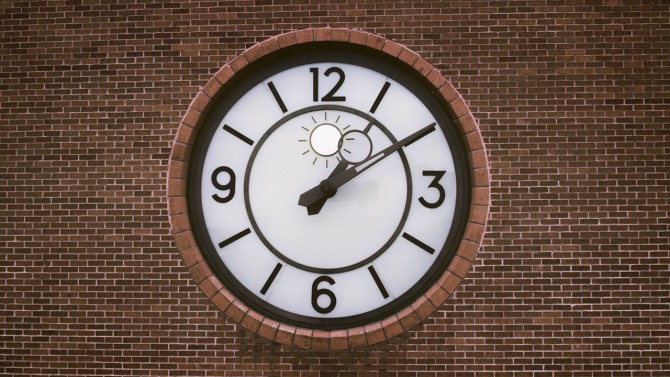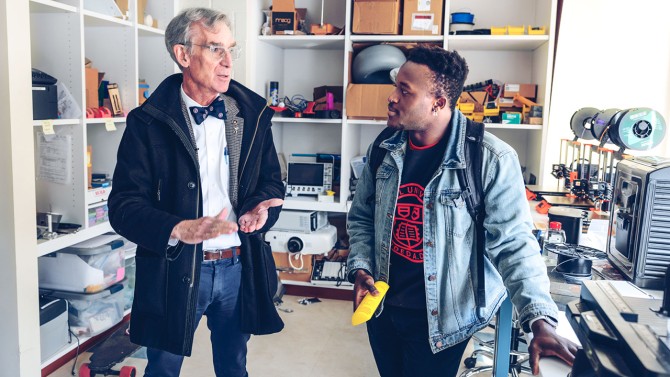Bill Nye ’77 returned to campus in March to see the progress that a Big Red engineering team has made on a revamp of the solar noon feature on the Rhodes Hall clock that bears his name. He chatted with students and faculty, drew adoring crowds, and led a test of the clock’s new controller.
With ‘Solar Noon’ Clock, Bill Nye ’77 aims to leave a legacy
By Joe Wilensky
This story was originally published in Cornellians.
When Bill Nye ’77 – the famed science popularizer, climate advocate and TV personality – served as a visiting professor on campus in the early 2000s, he’d often walk by Rhodes Hall and notice that in the center of the building’s parapet was an intriguingly blank concrete circle. “It just didn’t look right – somebody meant to put a clock there,” Nye recalls thinking. “Let’s put a clock there!”
But the instrument that Nye set out to design would be no ordinary timepiece. It would include an indicator of “solar noon”– the highest daily position of the sun in the sky.
Jump ahead some two decades: the Bill Nye Solar Noon Clock is now a campus fixture. And in March, TV’s beloved “Science Guy” made his latest visit to the Hill, during which he checked out an ongoing overhaul of the clock’s control system by a team of Big Red engineers.
What’s solar noon, anyway?
Only rarely coinciding with 12:00 on a conventional clock, solar noon varies by as much as 20 minutes depending on where you are on the planet. For centuries, seafarers used it for daytime positioning and navigation. “You would wait, wait, wait for the sun to be the highest in the sky – ‘make it noon’ is the expression,” Nye explains. “And then from there, you would calculate everything about your position on the Earth’s surface.”
Nye’s interest in the subject stems in part from his father’s experiences in World War II. Already an amateur astronomer, Ned Nye became fascinated with sundials during his nearly four years in a Japanese POW camp, where he used a sawed-off shovel handle to determine his location and mark the passage of time; he later wrote a book and newspaper columns about sundials.
In designing Cornell’s instrument, Nye’s original idea was to add a slit-shaped skylight to the building to illuminate the clock at solar noon– but calculations showed that to work, the skylight would have had to be nearly 60 feet long.
He then thought about the two Solatube lights he has in his L.A. home. Each has a roof-mounted, light-gathering dome with a lens that funnels daylight down a highly reflective tube to illuminate a flat disc, as well as internal flaps that can be opened and closed to serve as dimmers.
For the control system, Nye worked with mechanical and aerospace engineering professor Michel Louge, who tapped a group of students to help program and design a system to govern the opening and closing of the mechanism, timed to peak exactly at Ithaca’s solar noon each day.
The 10-foot-diameter clock– sporting a 14-inch solar noon indicator disc located just below the “12” on its face– was unveiled in August 2011 during a daylong celebration that included Nye’s live countdown and play-by-play narration, attended by hundreds.
Even through Ithaca’s cloudiest days, the instrument did its job – until April 2019, when the software controlling the solar noon indicator failed, a Y2K-like mishap where it suddenly began reading the date as 2099. (The regular timekeeping function, controlled separately, was unaffected.)
A new programming challenge
Like so many projects, fixes to the solar noon indicator (as well as the College of Engineering’s planned refreshes to the clock’s webpage design and live cam) were delayed by the pandemic. But in fall 2021, a team of engineering students set to work on repairing it.
Under the guidance of electrical and computer engineering senior lecturer Joe Skovira, Ph.D. ’90, the student leaders (M.Eng. candidate Kristin Lee and Smith Charles ’23) and their team designed a replacement control system, developed new software, and added redundancies for stability and backup. They used off-the-shelf components and parts wherever possible – and documented everything they did, to inform any future fixes or updates.
By the time Nye – whose current work includes serving as CEO of the Planetary Society, the space interest group co-founded by Cornell’s own Carl Sagan – came to campus on March 15, it was up and running.
Cheers for a science celebrity
During the visit, the former mechanical engineering major was enamored with all aspects of the clock, its revamped control system and the student team’s tweaks and plans. He spent several hours with them on Rhodes Hall’s top floor and in labs; no detail escaped his attention as he pulled out his laptop to check schematics, original design documents and calculations.
But he also was philosophical – pondering the clock’s longevity and its planned presence on the Hill for decades to come, as well as his own upcoming Reunion.
“That’s a feature of coming back to campus after 45 years – it’s [knowing] you’re gonna die,” he says wryly. “And so what you want in a gizmo like this clock on Rhodes Hall is for it to work for a long time. You want it to have a life like McGraw Tower. It’s venerable, it’s beautiful. It’s part of our history.”
And Nye’s big-picture thinking extends – as did Sagan’s – beyond our “pale blue dot” of a planet. He wants the clock not only to educate its observers, but to spark wonder for generations to come.
“I hope it gives you pause for thought about your place in space,” he said to the crowd that had gleefully followed him out to Hoy Field to watch the successful test. “We’re on a planet going around a star and yet, we can figure that out – and that’s astonishing. Something Carl Sagan said is that we are made of ‘star stuff,’ and yet we can understand this. So we are one way that the universe knows itself. Whoa!”
Get Cornell news delivered right to your inbox.
Subscribe



